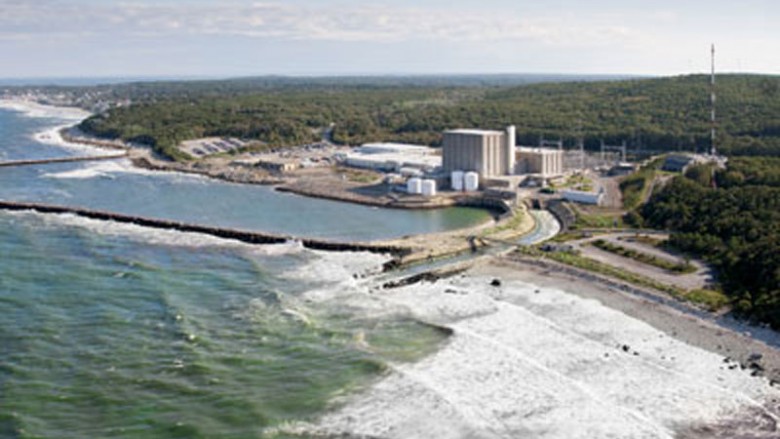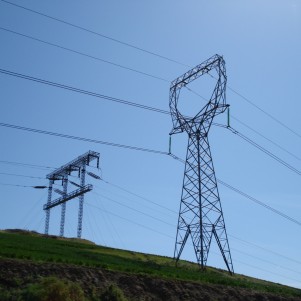Pilgrim power plant closing plan heats up state’s energy debate
By State House News Service | October 13, 2015, 18:30 EDT
 http://www.pilgrimpower.com/
http://www.pilgrimpower.com/ PLYMOUTH — Hampered by heightened federal oversight of its operations and low natural gas prices, the owners of Pilgrim Nuclear Power Station, which began operations in 1972, announced plans Tuesday to close the Plymouth facility by 2019, jolting the regional electricity market, spurring new calls for renewable energy, and forcing Massachusetts officials to think about long-term plant decommissioning and plans for spent nuclear fuel.
The announcement Tuesday morning by Louisiana-based Entergy Corp. triggered a wave of reactions. Pilgrim workers urged Entergy to reconsider, citing 600 jobs and the plant’s role in covering about 12 percent of the state’s electricity needs. Gov. Charlie Baker said the closure could mean an energy shortage and promoted his hydro energy plans. Solar energy, transmission, and other power industry officials said they were ready to fill voids. Sen. Edward Markey urged Entergy to devote the resources needed to remove spent nuclear fuel from an “overcrowded” pool. And officials began coming to grips with potential adverse impacts in the area where Pilgrim is located.
Pilgrim generates 680 megawatts of electricity, or enough to power more than 600,000 homes.
“It’s a temporary blow,” South Shore Chamber of Commerce President and CEO Peter Forman told the News Service. “It’s going to be a blow to Plymouth. It’s going to be a blow to the energy supply.”
Entergy said shale gas production had dropped natural gas prices and “significantly” affected Pilgrim’s revenues. Entergy blamed a $40 million reduction in Pilgrim revenues on a drop in current and forecast power prices of about $10 per megawatt hour.
But Pilgrim also faced higher operational costs in connection with the Nuclear Regulatory Commission’s announcement in September that they will increase oversight of the plant after inspectors raised concerns about findings associated with the performance of a safety relief valve. The NRC findings stem from a special inspection at the plant following its unplanned shutdown in January. Entergy estimated up to $60 million in direct costs associated with enhanced NRC inspections, not including costs that might arise due to inspections.
Pilgrim was expected to incur after-tax net losses ranging from $10 million to $30 million for 2015, 2016, and 2017, before taking into consideration plans to close the plant or costs associated with testing the plant for “impairment” in connection with the NRC’s heightened oversight.
Entergy said Pilgrim would close by June 1, 2019, with the exact timing to be determined during the first half of 2016 following talks with ISO-New England, the region’s electric grid operator.
Rep. Thomas Golden (D-Lowell) said he shares concerns about lost jobs and tax revenues in the Plymouth area. Pilgrim’s closure will take a significant energy source offline and raises the stakes for ongoing energy policy talks. “Four years gives us some time,” Golden told the News Service. “I don’t think there’s reason to panic today.”
While calling Pilgrim’s closure “something that has to be taken into serious consideration sooner rather than later,” Golden said he favors continuing a “very slow approach” on energy policy.
“I don’t think it’s something we can rush,” he said. “We still have committee hearings going on. The members of the House are weighing in very, very heavily. This is something we need to get right. I really believe it is the issue of the decade-plus.”
Golden identified energy storage as a potential “big game changer,” and said policymakers are likely to be dealing for years with changes in energy technology.
Entergy indicated state energy proposals influenced its decision.
In addition to citing wholesale energy market “design flaws” that adversely affect prices paid for nuclear energy, Entergy also said Pilgrim’s performance had been “undermined by unfavorable state energy proposals that subsidize renewable energy resources at the expense of Pilgrim and other plants.” Entergy also described as “detrimental” proposals to provide “above-market prices to utilities in Canada for hydro power” and a state agency order that the company said would further lower natural gas prices and reliance on the fuel.
“The decision to close Pilgrim was incredibly difficult because of the effect on our employees and the communities in which they work and live,” Leo Denault, Entergy chairman and CEO, said in a statement. “Our people at Pilgrim are dedicated and skilled, a wonderful blend of young professionals and seasoned, experienced veterans, who for decades have been generating clean power and contributing millions of dollars of economic activity to the region. But market conditions and increased costs led us to reluctantly conclude that we had no option other than to shut down the plant.”
A decommissioning process will follow the plant’s closure. Entergy said there was $870 million in a Pilgrim decommissioning trust as of Sept. 30, 2015, “representing excess financial assurance of approximately $240 million for license termination activities above NRC-required assurance levels.”
Future NRC filings will address funding for spent fuel management, “which will be required until the federal government takes possession of the fuel and removes it from the site, per its current obligation.” Entergy said it does not anticipate additional funding.
Gov. Charlie Baker said the decision to close Pilgrim did not surprise him given what was known about its finances and the safety upgrades that were needed, and pledged to stay involved with Entergy, the NRC and ISO New England as the closure moves forward.
“On some level it creates a certain sense of urgency around our hydro proposal, which would make it possible for use to generate significant megawatts to serve that baseload loss on a go-forward basis and to do so in a way that would be competitive and cost effective for business and families in New England,” Baker told reporters Tuesday morning.
Baker said hydropower holds the potential to more than replace the energy that will be lost when Pilgrim closes. “That’s one of the reasons I want to test the water on hydro, pun intended,” Baker said. “There’s thousands of megawatts of relatively affordable clean renewable energy coming from hydro providers all over the northeast and in Canada and we should test the waters with them and see how much power they think they can generate to support our baseload requirements.”
Asked how quickly hydropower could be put online given opposition to transmission projects like Northern Pass through the White Mountains of New Hampshire, Baker said, “It all depends on when the legislation would pass that would make it possible for us to test the market and see what’s out there. There are four or five different routes between New York and the New England states that can get down into the New England region and connect, from a transmission point of view. Actually, I was surprised at how many options were available to us. There are a lot more than just the Northern Pass.”
Baker said his administration has talked to Pilgrim about its 600 employees and understands the “vast majority” will be put on “retention agreements” with some working through the plant’s closure before they retire and others moving to other Entergy facilities.
“We’ll work very hard to make sure that anybody else who’s left at the end of that two- or three-year period has options to pursue if they want to stay here and continue to work,” Baker said.
While workers urged Pilgrim to reconsider closure, Baker said, “The only scenario under which I would be willing to even consider aggressively advocating for Pilgrim to stay open would be if they deal with all the safety issues that have been raised over the course of the last several years.”
— Written by Michael Norton and Matt Murphy
Copyright State House News Service
RELATED:
Pilgrim Nuclear and the paradox of green energy










